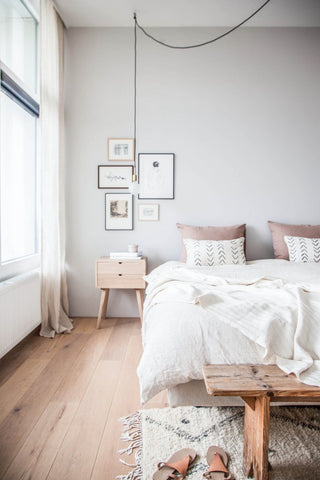Are we minimalists? Are we zero waste? I’d like to think we’re both, but I definitely don’t believe you have to be 100% of anything to call yourself such. Both are ideals we strive towards. They are both a journey, an objective that guides our choices.

We are minimalists, but also far from minimalists. With three little boys, full-time jobs and the need for convenience, we have chosen to use minimalism as a guide for reducing our possessions and our consumption, but without going to extremes.
Simplifying our home has resulted in a more organized (and easy to organize), more beautiful and cleaner home! It is both easier and less stressful to organize, clean and find things in. And we don’t miss the things we got rid of one bit.
It can seem difficult to find the right balance between minimalism and comfort, but the right balance is different for everyone.
ZERO WASTE MEANS SIMPLIFYING
For me, zero waste means sending as little as possible to a landfill, and also as little as possible to be recycled (as we know plastic is mostly not recycled). For most of us, it’s an ideal we aspire to, a journey with a destination we may never quite reach but that we’re always working towards. One of the biggest realizations for our family was that if we want to reduce waste, we have to reduce what comes into our home.
Zero waste means simplifying. We are less tempted by sales and advertisements, and instead spent time researching the best quality solution for our needs. Gone are the days of splurging on too many things or compulsive shopping (which I will admit I was guilty of in what seems now to be another life!).
After learning so much about the waste problems of the world, and becoming more and more accustomed to less packaging, we notice the packaging in supermarkets on every shopping trip.

We don’t have rules and we are not by any means extremists, but simply notice and let our knowledge guide our decisions. If zero waste alternatives or making the item ourselves is not a reasonable option, we’ll make the purchase anyways – we are human after all! It’s not about deprivation but rather making conscious choices. We think about the life cycle of a product before we make a purchase: what’s it made from, will it last, and how can it be disposed of it at the end of its life?
And here we come to minimalism!
Minimalism is about keeping only things that are useful or practical, and getting rid of the clutter.
Some may see zero waste as meaning they don’t throw anything away because it could be used one day – why send it to the landfill? But when allowing both zero waste and minimalism in decisions, and reducing the amount of purchases, they can actually be very complementary together.
Minimalism makes us question our consumption choices and look carefully at our shopping habits. Most importantly, it makes us buy less of what we don’t need – meaning less waste.
THE LIFE-CHANGING MAGIC OF TIDYING UP
That is why I loved Marie Kondo’s book, The Life-Changing Magic of Tidying Up. Her approach encourages you to simplify, keeping only those items that “spark joy,” which allows you to apply based on your unique situation and preferences, while still achieving the goal of simplifying.
 Her book guides you through the steps of taking one area of the home at a time, putting everything on the bed or ground (to see the sheer magnitude of our possessions) and deciding one at a time which items spark joy. That dress you haven’t worn in 8 years? If it sparks joy, fine, keep it! If not, it’s time to let it go. Without consideration of how much you spent, how many times you’ve worn it, whether you might maybe, possibly, one day in the future wear it again, doesn’t matter. Joy is the deciding factor.
Her book guides you through the steps of taking one area of the home at a time, putting everything on the bed or ground (to see the sheer magnitude of our possessions) and deciding one at a time which items spark joy. That dress you haven’t worn in 8 years? If it sparks joy, fine, keep it! If not, it’s time to let it go. Without consideration of how much you spent, how many times you’ve worn it, whether you might maybe, possibly, one day in the future wear it again, doesn’t matter. Joy is the deciding factor.
FUTURE BENEFITS
Another benefit is the impact it has on your future purchases, along with our awareness of the importance of sustainability. Now before buying something, we think about where it came from, who made it, what are the ingredients/materials, what is the carbon footprint, and last but not least, where will it end up after we have finished using it! Now we meditate thoughtfully and consider multiple times before making a purchase, and no longer suffer from buyers remorse or impulse buying.
CONCIOUS DISPOSAL
The only major complaint I have about the book is Marie’s lack of addressing how to dispose of the surely significant amount of items each person lets go. The book focuses on keeping only the essential but leaves the reader free to send many trash bags full of clothes and other items to the landfill. One of the most important actions to take when reducing is to think carefully about how to best give those items a second life.
There are thankfully some wonderful resources out there and more popping up often offering a resource for buying and selling used goods. Some examples we are aware of are:
Subito
Armadio Verde
Vestiare Collective
Debop
Caritas
Facebook groups
Second hand stores near you!
